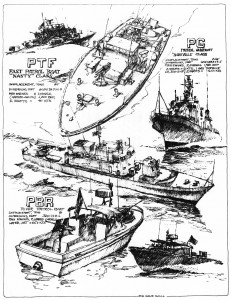What Does Cic Stand for in the Navy

PTF (Fast Patrol Boat "Nasty" Class), PG (Ashville Class Patrol Gunboat), and PBR (River Patrol Boat) (Sketch by John Charles Roach, NHHC L-File)
2012 marks the beginning of commemorations for the 50th anniversary of the Vietnam War. The United States of America Vietnam War Commemoration has launched a website (www.vietnamwar50th.com) which has information on the anniversary, and on the war itself. The website is a work in progress, and features an expansive interactive timeline of the war, featuring images and reference material. The Naval Historical Foundation will also be taking steps to commemorate the 50th anniversary of the Vietnam War. We are planning a major announcement soon on new Vietnam exhibit construction at the Cold War Gallery. We're also planning to do a series of stories throughout the year on the Navy's role in the war, and we want to begin the series with a number of stories on the "Brown Water Navy."
Late last year, we heard from a number of our NHF Members about the History Channel's 2011 documentary Vietnam in HD. These Members, veterans of the war, were concerned that the documentary did not provide adequate coverage of the Brown Water Navy. During the War, sailors of the U.S. Navy braved over 3,000 nautical miles of perilous rivers and canals threading the landscape of Vietnam. The River Patrol Force was established on 18 December 1965, and for the remaining years of the war, Navy patrol boats were a common sight on the waters of Vietnam. Their mission was broad and covered a number of contingencies. The infrastructure of Vietnam was devoid of superhighways and sophisticated rail systems, thus waterways served as a primary means of transportation. Control of the waterways was crucial. The primary mission of the River Patrol Force was to intercept and interdict Communist supplies being smuggled from the North. Additionally, they delivered and supported land forces (including Navy SEALs) and engaged North Vietnamese forces ashore with onboard weaponry.
The sailors who served in the Brown Water Navy endured unique forms of hardship and danger. Small craft such as PBR's (River Patrol Boats, see sketch above) made their way deep into inland waterways, surrounded on both sides by impenetrable jungle. Gunfire could erupt from the dense forests along the shore at any time, often from cleverly concealed enemy positions just yards away. These lightly armored patrol boats were built for speed, and offered little protection to their crews. Vietnamese sampans and small craft were intercepted on a daily basis and search for contraband materials – always a tense and potentially dangerous situation.
Sailors of the Brown Water Navy also battled the natural environment of Vietnam, enduring punishing heat and pounding monsoons. They contended with shallow, narrow waterways, whose constantly changing waters overflowed and flooded during the monsoon season. And of course, like all who serve, they spent many a lonely day, thinking about a home on the other side of the world.
To whet your appetite on the topic, we'd like to begin with this 30 minute documentary, "River Patrol." This 1967 U.S. Navy documentary gives a sense of the hardships endured by sailors of the Brown Water Navy. It follows PBR's and UH-1B Seawolf helicopters operating from USS Harnett County (LST 821) in the area of the Co Chien River.
We're working closely with several of the veterans of the Brown Water Navy, and plan to highlight different aspects of their experiences throughout the year. Stay tuned for more stories in the months to come. In the meantime, please visit the Virtual Exhibit we've posted online at www.usnavymuseum.org, entitled Vietnam War Afloat and Ashore.
What Does Cic Stand for in the Navy
Source: https://www.navyhistory.org/2012/01/brown-water-navy-in-vietnam/

0 Response to "What Does Cic Stand for in the Navy"
Post a Comment